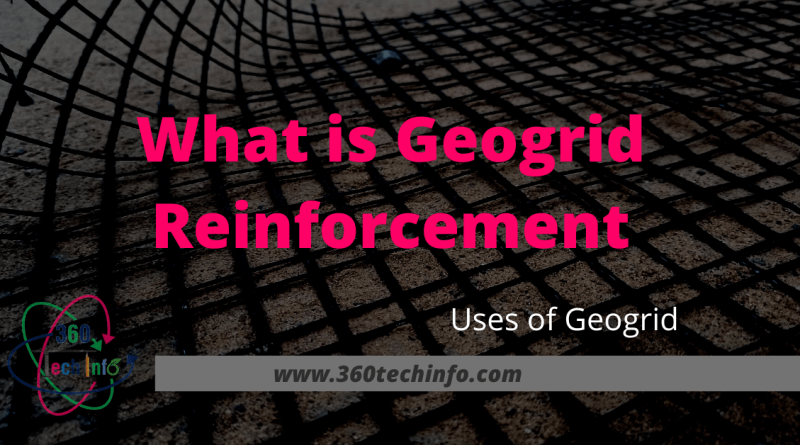What is Geogrid Reinforcement
1. What is Geogrid?
Geogrid is a type of geosynthetic material that is used in the construction of roadways, retaining walls, and other civil engineering structures. It is made from a high-density polyethylene (HDPE) material and is designed to reinforce soil and aggregate layers. Geogrid works by increasing the overall strength and stability of soil and rock, helping to prevent sliding, erosion, and settlement. The material is commonly used in applications where the ground is not strong enough to support the weight of a structure, or where soil is prone to movement or erosion. Geogrid is a cost-effective solution for enhancing the performance of roadways, retaining walls, and other civil engineering structures, and is widely used in a variety of construction projects around the world. What is Geogrid Reinforcement
2. Use of Geogrid/ What is Geogrid Reinforcement
Geogrid is used in a variety of civil engineering and construction applications, including:
- Road construction: Geogrid is used to reinforce the subgrade beneath roadways, helping to reduce rutting, cracking, and other forms of pavement distress.
- Retaining walls: Geogrid is used to reinforce retaining walls, helping to prevent movement and collapse of the structure.
- Embankments and slopes: Geogrid is used to reinforce soil and rock layers on slopes and embankments, helping to prevent erosion and instability.
- Landfills: Geogrid is used in the construction of landfill liners to reinforce the barrier and prevent the migration of contaminants into the surrounding environment.
- Mine reclamation: Geogrid is used in the reclamation of mines to reinforce soil and rock layers and prevent erosion and instability.
- Coastal protection: Geogrid is used to reinforce dunes and shorelines, helping to prevent erosion and protect coastal areas from storm surges and sea level rise.
Overall, the use of geogrid can help to improve the performance and stability of civil engineering structures, reduce maintenance costs, and provide long-term durability and protection.
3. Raw Material of Geogrid
The raw materials used in the production of geogrid typically include high-density polyethylene (HDPE) or polypropylene (PP). These materials are chosen for their strength, durability, and resistance to UV light and chemical degradation.
The HDPE or PP material is melted and extruded through a machine to create long, thin strips that are then woven or welded together to form a grid-like pattern. The resulting geogrid material is then rolled and packaged for shipping.
In addition to HDPE and PP, some geogrid products may also contain other materials, such as carbon black or UV stabilizers, to improve the strength, durability, and resistance to environmental factors. The specific raw materials used in the production of geogrid will depend on the intended application and desired properties of the final product.
4. Use of Geogrid for Reinforced Retaining Wall
Geogrid is commonly used in the construction of reinforced earth walls, also known as geosynthetic reinforced soil (GRS) walls. The basic idea behind using geogrid in these types of walls is to reinforce the soil and improve its load-bearing capacity. This helps to reduce the overall size and weight of the wall and can make the wall more stable and resistant to movement.
Here’s how geogrid is used in reinforced earth walls:
- The first step is to prepare the base and foundation of the wall. This may involve excavation and preparation of a trench or foundation for the wall.
- Geogrid is then laid in the trench or foundation and secured in place. The geogrid serves as a reinforcement layer and helps to distribute the load of the wall evenly across the soil below.
- A layer of soil is then placed over the geogrid. This layer can be made up of a variety of materials, including crushed rock, sand, or other types of soil.
- The next step is to install the facing or retaining wall system. This may be made of precast concrete panels, masonry blocks, or other materials.
- The final step is to backfill the wall with soil, either behind or in front of the facing. This helps to stabilize the wall and prevent movement or settling.
Using geogrid in the construction of reinforced earth walls can help to increase the stability, strength, and performance of the wall, while reducing the amount of material required. Additionally, geogrid helps to reduce the amount of excavation and backfilling required, making the construction process faster and more cost-effective.
5. How Geogrid for Railway / What is Geogrid Reinforcement
Geogrid is commonly used in the construction of railway systems to reinforce the subgrade and improve the performance of the railway track. The basic idea behind using geogrid in railway systems is to distribute the load of the trains evenly across the subgrade and prevent settling and instability.
Here’s how geogrid is used in railway systems:
- The first step is to prepare the subgrade or base layer beneath the railway track. This may involve excavation and preparation of the subgrade, including compaction and stabilization of the soil.
- Geogrid is then laid over the prepared subgrade and secured in place. The geogrid serves as a reinforcement layer and helps to distribute the load of the trains evenly across the subgrade.
- The railway track is then laid over the geogrid. The track may consist of ballast, sleepers, and other components, depending on the type of railway system.
- The final step is to backfill the track with ballast or other materials, as needed. This helps to stabilize the track and prevent settling or instability.
Using geogrid in the construction of railway systems can help to improve the performance and stability of the track, reduce maintenance costs, and increase the life span of the railway system. Additionally, geogrid can help to reduce the amount of excavation and backfilling required, making the construction process faster and more cost-effective.
What is Geogrid Reinforcement
6. Use of Geogrid for Slope Protection
Geogrid is used in the construction of slope stabilization systems to help protect against landslides and other types of slope failure. The basic idea behind using geogrid in slope stabilization systems is to reinforce the soil and improve its load-bearing capacity, which helps to prevent movement and instability.
Here’s how geogrid is used in slope stabilization systems:
- The first step is to assess the slope and identify the areas that are most at risk of failure. This may involve soil testing, geotechnical analysis, and other types of assessments.
- Geogrid is then installed on the slope in the areas that have been identified as most at risk. The geogrid serves as a reinforcement layer and helps to distribute the load of the soil evenly across the slope.
- A layer of soil or other materials may be placed over the geogrid to further reinforce the slope. This may include the placement of soil nails, rock anchors, or other types of reinforcement systems.
- The final step is to backfill the slope with soil or other materials, as needed. This helps to stabilize the slope and prevent movement or instability.
Using geogrid in the construction of slope stabilization systems can help to reduce the risk of landslides and other types of slope failure. Additionally, geogrid can help to improve the stability and performance of the slope, reduce maintenance costs, and increase the lifespan of the slope stabilization system.
7. Conclusion
In conclusion, geogrid is a versatile and widely used material in civil engineering and construction. Its primary function is to reinforce soil and improve its load-bearing capacity, which makes it suitable for a variety of applications, including:
- Reinforced earth walls
- Railway systems
- Slope stabilization systems
- Road construction and rehabilitation
- Retaining walls
- Embankments and dam construction
The use of geogrid can help to improve the stability, performance, and longevity of these structures, while reducing the amount of material required and making the construction process faster and more cost-effective. Geogrid is typically made from high-density polyethylene (HDPE) or polyester (PET) materials, which are strong, durable, and resistant to UV light and environmental degradation.
In conclusion, geogrid is an important material in modern civil engineering and construction, offering a range of benefits and solutions to many of the challenges faced by engineers and contractors. What is Geogrid Reinforcement




